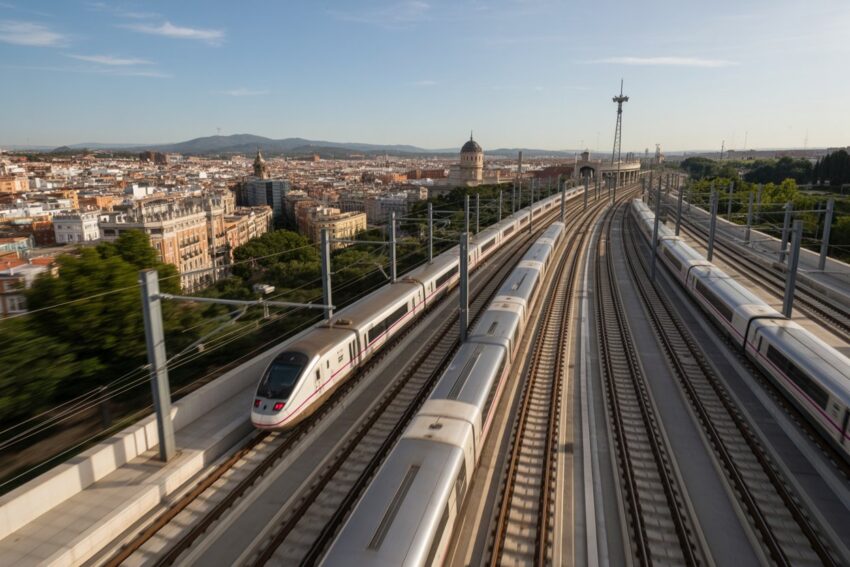Spain Set to Launch Three New High-Speed Rail Routes in 2026, Further Advancing Market Liberalisation
Spain announces the opening of three new high-speed routes to competition in 2026, continuing its rail market liberalisation efforts.
Spain is taking significant strides towards modernising its high-speed rail system with the announcement of the next phase in the liberalisation of its rail market. The Spanish infrastructure manager, Adif, and its high-speed rail counterpart, Adif AV, have confirmed that three new routes will be opened to competition starting in 2026. This move follows the successful implementation of the first phase of market liberalisation and is expected to bring greater efficiency, better services, and more affordable fares to passengers, all while contributing to Spain’s economic growth and environmental sustainability.
Opening Three Key Routes to Competition
As part of the second phase of the market opening, high-speed operators will be able to request paths on three major routes that connect Madrid with other important regions in Spain. The details of the new routes include:
Madrid to Galicia: The new route connecting Madrid with the cities of A Coruña, Santiago de Compostela, and Vigo in the northwestern region will have up to 32 paths a day available for high-speed rail operators.
Madrid to Asturias and Cantabria: Linking Madrid with northern Spain, this route will provide up to 24 paths a day connecting cities such as Oviedo, Gijón, and Santander, further improving accessibility in this part of the country.
Madrid to Andalucía: This southern route will offer up to 16 paths a day, connecting Madrid with the cities of Cádiz and Huelva, helping boost connectivity in the southern region of Andalucía.
The liberalisation of these routes is a critical component of Spain’s broader strategy to create a competitive, efficient, and accessible rail network. The paths for these new services have already been shared with operators for consultation and will be formally published in the amended network statements for 2026. These network statements will include crucial details such as the timetable for allocating paths, the rules for the process, and further guidelines for operators.
Outcomes from the First Phase of Market Liberalisation
The first phase of Spain’s rail market liberalisation, which began in 2020, has already yielded impressive results, increasing competition and enhancing services on high-speed routes. This initial phase saw the signing of framework agreements with Spain’s state-owned operator Renfe, as well as new entrants Ouigo and Iryo, who began operating high-speed services on the popular Madrid – Barcelona, Madrid – Valencia, and Madrid – Seville/Málaga routes.
The impact of the first phase has been significant. The number of seats available on these high-speed routes has increased substantially, with:
- A 64.8% increase in seat availability on the Madrid – Barcelona route between 2019 and 2024.
- A 113.1% increase on the Madrid – Valencia route.
- A 52.55% increase on the Madrid – Seville and Málaga services.
These increases in capacity have translated into a better travel experience for passengers. High-speed rail fares have dropped by an average of 33%, excluding inflation, leading to significant savings for consumers. The estimated savings in fares for passengers in 2024 compared to 2019 stand at around €431.3 million, a reflection of the positive outcomes of introducing competition.
Environmental and Economic Benefits
The liberalisation of the high-speed rail market has not only benefited passengers with more affordable travel options but has also contributed significantly to Spain’s environmental goals. With increased competition and more rail services, the total number of commercial passengers on high-speed trains reached 49 million in 2024—an increase of 42% compared to 2019. This shift to rail has contributed to a reduction in carbon emissions, with 900,000 passengers shifting from air travel to high-speed rail and 3.7 million passengers switching from road transport. This modal shift has resulted in estimated savings of €171.8 million in external costs such as reduced emissions, road accidents, and traffic congestion.
The overall societal benefit of this transition has been estimated at €503.9 million. This has been a positive outcome not only for the environment but also for Spain’s economy, as Adif has made a net profit of €133.3 million from the increase in rail traffic and the rise in track access income.
Looking Ahead: The Future of Spain’s High-Speed Rail Network
The second phase of market liberalisation, which will open up these new routes for competition, is expected to build on the success of the first phase. The government’s continued commitment to improving the rail sector is part of a larger effort to modernise Spain’s transport infrastructure, making it more sustainable, efficient, and competitive on a global scale.
The upcoming liberalisation of the La Dorada – Chiriguaná railway line and the continued expansion of high-speed services are set to increase Spain’s connectivity and reinforce the country’s position as a leader in high-speed rail. The ongoing competition in the market will not only benefit consumers with lower prices and better services but will also contribute to a more sustainable transport future.
With the second phase of market liberalisation set to begin in 2026, Spain’s rail system is moving towards an even more interconnected, affordable, and competitive future, benefiting both passengers and the environment.
The post Spain Set to Launch Three New High-Speed Rail Routes in 2026, Further Advancing Market Liberalisation appeared first on Travel and Tour World


Comments and Responses
Please login. Only community members can comment.